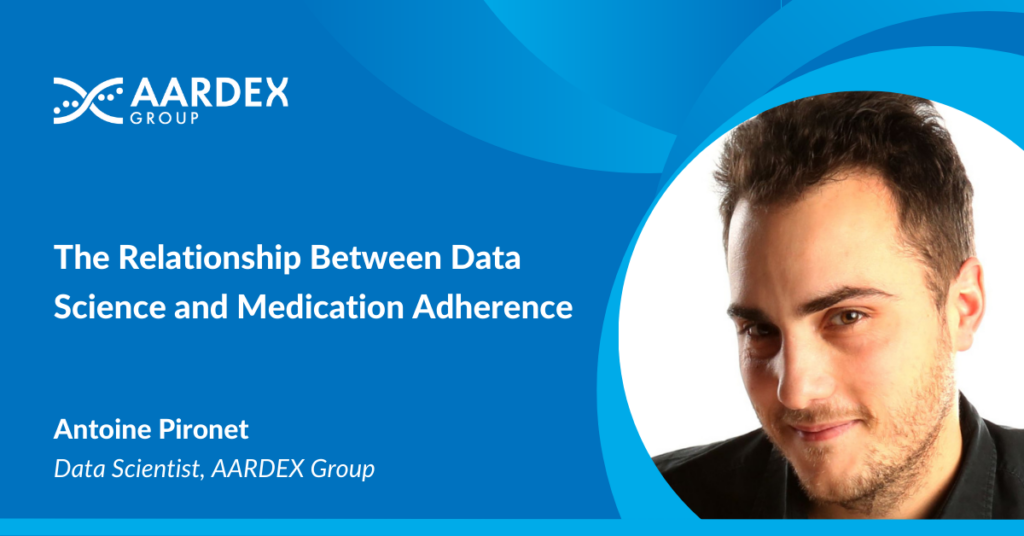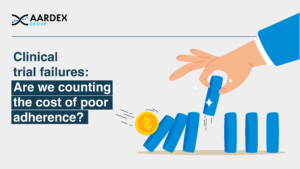This article was originally posted on the Applied Clinical Trials website.
Non-adherence to medication is a long-standing problem – not just for health outcomes but also for the success of clinical trials. Across all studies, therapeutic areas and stages of development, around 50% of participants admit they do not adhere to the dosing regimen set out in the protocol[1] and around 30% of subjects in Phase III studies are non-adherent by day 100[2].
Trials often rely on the traditional, manual methods of adherence monitoring. However, these have been shown to be lacking. Fortunately, the technology and the expertise needed to take control of medication adherence not only exists but is relatively easy to implement.
Antoine Pironet, Data Scientist at AARDEX Group takes a closer look at the role of data science, how it can help us understand patient behavior and why digital adherence solutions are the future.
The relationship between data science and medication adherence
Data science is particularly useful for analyzing large sets to identify patterns, including causal relationships. What is very specific to medication adherence data, particularly when you are looking at electronic monitoring data, is the complexity of the data over time and its context. In fact, dosing history data consists of a series of time points corresponding to when the person will access their package to use a medication. So that makes it a very specific type of data requiring specific types of analysis where most of the information is when there is no medication taken and thus no datapoint. Rather than providing raw data which will be cumbersome to interpret, because of the very large number of data points, data science is about processing this data to provide data-driven and effective feedback to patients and healthcare professionals to improve medication adherence.
But why do we need to improve medication adherence? The impact of medication non-adherence can be huge from drug development to medical practice. Partial adherence or nonadherence is a confounding factor in the interpretation of clinical trial results, with consequences that include underestimated efficacy of new drugs, to the point of trial failure; underestimated incidence of adverse effects; distorted pharmacoeconomic analyses; and/or overestimated dosing requirements for marketed pharmaceuticals. Study power is critical during clinical trial design. The higher the study power, the higher the probability of detecting a drug’s true effect. When subjects do not take their medication as directed, it can potentially decrease effect size and increase variability. This, in turn, drains study power. The exponential relationship between non-adherence and sample size means any decrease in adherence must be met with an expensive, labor-intensive increase in the number of study participants if power is to be maintained. This means non-adherence has a direct effect on the cost and duration of clinical trials and can slash return on investment. Non-adherence also has wider health outcome implications, from lower quality of life and wasted medications to severe health complications and premature death.
So how can data science help? Using over 9 million adherence data points from the AARDEX knowledge center, we have developed a powerful suite of algorithms that enable us to depict individual medication intake behaviors as well as changes that occur over time. Studying a patient’s successive behaviors helps us understand if a patient has satisfactory medication adherence and, if not, identify what support might be needed. We can help healthcare providers to ask the right questions about why a patient is non-adherent. We can give sponsors insight into individual site performance to highlight trial sites which need to improve their medication adherence support. Data science uses the same raw data to provide different types and levels of information to different people to support all stakeholders maintain fidelity to the research protocol.
The importance of understanding patient and medication intake behaviors
Barriers to medication adherence are both multiple and complex. However, there are some identified causes for non-adherence as identified by the World Health Organization (WHO):
- Erratic non-adherence, for example, forgetting due to a busy schedule or not prioritizing the condition.
- Unwitting non-adherence, for example, not fully understanding the treatment regimen.
- Intelligent non-adherence – a conscious choice not to take medication usually due to a fear of side effects or symptom cessation.
There can also be physical barriers to adherence, for example, difficulty swallowing. With medication adherence so unpredictable how can we change patient behavior?
The COM-B model of behavior is widely used to identify what needs to happen for a behavior change intervention to be effective. It identifies three factors that need to be present for any behavior to occur: capability, opportunity and motivation.
Digital adherence monitoring provides doctors or nurses with the right tools to perform an intervention. If the data allows us to deduce a measure of strength of the patient’s habit it can help us understand if the behavior is erratic, unwilling or intelligent. That, in turn, can help shape a relevant set of questions to ask during trial consultations. This support allows time to be spent more efficiently during patient discussions and allows medical professionals to pinpoint what specific support is needed to give patients the capability, opportunity and motivation to improve behavior.
Currently, when most people compute medication adherence, they put a number on the whole monitoring period – from first dose to end of protocol. This aggregate measure of adherence is losing time-sensitive information and is not reflective of all the different behaviors the subject exhibited during the trial. Many patients with totally different behaviors can end up having the same overall adherence number and yet require very different types of interventions, or even not require an intervention at all.
For example, one patient might have a therapeutic holiday, another one might stop the treatment too early while another might have good behavior in the morning but not in the afternoon. These three patients could have the same overall adherence number, but they require very different types of interventions. This is critical information to get for the sponsors and the people handling the clinical trial. It allows them to adapt how they interact with the patient during control visits or calls.
How digital adherence monitoring can help – solutions and benefits
Digital adherence monitoring gives trial leaders an invaluable insight into adherence levels. It allows them to identify the risk of medication non-adherence and mitigate it before it drains study power and interferes with study results. What is more, advanced digital monitoring provides a complete understanding of the patient adherence behaviors and the risk indicators that matter most for the success of a study.
Non-digital methods for compliance monitoring, such as pill counting or patient self-report diaries, are biased and not sensitive enough to detect non-adherence. User-friendly data-driven digital solutions are different. Studies have shown smart package monitoring is 97% accurate, compared to 60% for pill count, 50% for healthcare professional rating, and just 27% for self-report.[3]
User-friendly digital adherence monitoring consists of smart drug packaging / devices using microcircuitry to record dose administration and transmit information. At AARDEX, smart packaging and devices from our ecosystem record and share dosing data into our Medication Event Monitoring System Adherence Software (MEMS AS®) platform, creating a single comprehensive adherence solution. MEMS AS® can also be integrated with Electronic Data Capture (EDC), Interactive Response Technology (IRT) and third-party applications to provide sophisticated analysis of medication-taking behaviors. It can be integrated into patient-facing apps designed to build engagement, encourage adherence and develop strong medication-intake behaviors. Crucially, we are able to leverage past adherence data from more than 50,000 clinical trial patients to inform and guide strategies and interventions.
Adherence-informed trials lead to optimized drug development. The benefits include improved agreement to the medication intake schedule, improved data quality and statistical power, reduction in patient population size, and a reduced time to market. Digital monitoring can also help avoid errors in interpretation of patient risks and benefits.
Incorporating digital monitoring measures and using them to encourage adherence can radically increase the chances of a clinical trial’s success. It is the most cost-effective approach to compensate for the drop in study power that results from non-adherence. The better the data behind a study, the better the outcome for pharma, clinicians and patients themselves.
[1] How the EMERGE guideline on medication adherence can improve the quality of clinical trials https://doi.org/10.1111/bcp.14240
[2] Adherence to medications: insights arising from studies on the unreliable link between prescribed and actual drug dosing histories 10.1146/annurev-pharmtox-011711-113247
[3] A scoping review of studies comparing the medication event monitoring system (MEMS) with alternative methods for measuring medication adherence. https://bpspubs.onlinelibrary.wiley.com/doi/full/10.1111/bcp.12942



